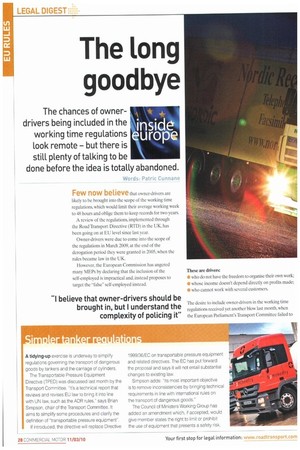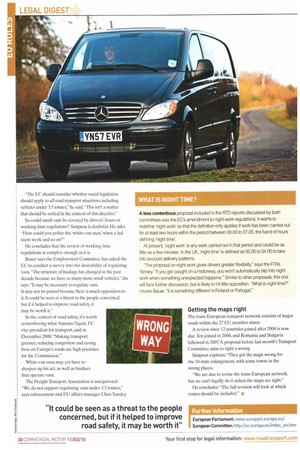The long goodbye
Page 28

Page 29

Page 30

If you've noticed an error in this article please click here to report it so we can fix it.
The chances of ownerdrivers being included in the working time regulations look remote but there is still plenty of talking to be done before the idea is totally abandoned.
Words: Patric Cunnane
Few now believe that owner-drivers are likely to be brought into the scope of the working time regulations, which would limit their average working week to 48 hours and oblige them to keep records for two years A review of the regulations, implemented through the Road Transport Directive (RTD) in the UK. has been going on at EU level since last year.
Owner-drivers were due to come into the scope of the regulations in March 2009, at the end of the derogation period they were granted in 2005, when the rules became law in the UK.
However, the European Commission has angered many MEPs by declaring that the inclusion of the self-employed is impractical and, instead proposes to target the "false" self-employed instead.
These are drivers: • who do not have the freedom to organise their own work; • whose income doesn't depend directly on profits made: • who cannot work with several customers.
The desire to include owner-drivers in the working time regulations received yet another blow last month, when the European Parliament's Transport Committee failed to
agree a +Aay forward. A report recommending their inclusion met with a split vote, plus one abstention. Its rapporteur (sponsor) MEP Said El Khadraoui agreed to withdraw the proposal.
It looks like regulation will be limited to the false self-employed," admits Brian Simpson, Labour MEP and chair of the Transport Committee."I believe that ownerdrivers should be brought in, but I understand the complexity of policing it. I would have more faith if the drivers' hours regulations were better policed."
Supporters of inclusion now look to the Employmer Committee, which leads on the matter.
It too reached stalemate last month, when it failed tc agree a definition of "self-employed".
A vote has been postponed until late April, and its rapporteur on the issue, Christian Democrat MEP Edil Bauer. expresses frustration at the impasse. She believ• it was a mistake to include the self-employed in 2002 when the issue was introduced.
"It was the first regulation that tried to include the self-employed," she says, adding that the measure has its supporters The socialists and greens are advocates of inclusion. After the Employment Committee, the propoi is likely to be debated at a full plenary session of the European Parliament in May. This one could run and rui
Regulating vehicles under 3.5 tonnes
El Khadraoui's report to the Transport Committee alsc included a proposal to regulate vehicles under 3.5 tonn if they are used for business purposes.
"The EC should consider whether social legislation should apply to all road transport situations, including vehicles under 15 tonnes," he said. "This isn't a matter that should be settled in the context of this directive.
So could small vans be covered by drivers' hours or working time regulations? Simpson is doubtful. He asks: "How could you police the 'white-van man', when a lad starts work and so on?"
He concludes that the review of working time regulations is complex enough as it is.
Bauer says the Employment Committee has asked the EC to conduct a survey into the desirability of regulating vans. "The structure of haulage has changed in the past decade because we have so many more small vehicles," she says."It may be necessary to regulate vans.
It may not be passed because there is much opposition to it. It could be seen as a threat to the people concerned, but if it helped to improve road safety, it may be worth it."
In the context of road safety, it's worth remembering what Antonio Tajani, EC vice-president for transport, said in December 2008: "Making transport greener, reducing congestion and saving lives on Europe's roads are high priorities for the Commission."
White-van man may yet have to sharpen up his act, as well as hauliers that operate vans.
The Freight Transport Association is unequivocal. "We do not support regulating vans under 3.5 tonnes," says enforcement and EU affairs manager Chris Yarsley.
Getting the maps right
The trans-European transport network consists of major roads within the 27 EU member states.
A review since 12 countries joined after 2004 is now due. Ten joined in 2004, and Romania and Bulgaria followed in 2007 A proposal before last month's Transport Committee aims to right a wrong.
Simpson explains: "They got the maps wrong for the 10-state enlargement, with some towns in the wrong places.
"We are due to revise the trans-European network, but we can't legally do it unless the maps are right."
He concludes: "The full revision will look at which routes should be included." •








































































































































